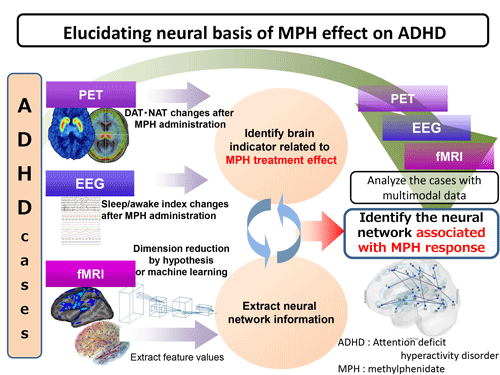- HOME
-

- Research
1-1
Identification of the pathogenic mechanism of mental and neurological disorders through acquisition and analysis of cerebral MRI-scan images and clinical data, etc.
The mechanism of brain development and disorders in adolescence and young adulthood (AYA) through international MRI collaborations

Kiyoto KASAI
M.D., Ph.D., Professor, Graduate School of Medicine,
The University of Tokyo
The onset of many psychiatric disorders usually occurs in adolescents and young adults (AYA). The substrates of brain maturation in the AYA generation largely remain undiscovered. In our current research project, we will acquire longitudinal MRI data of patients with schizophrenia, those with developmental disorders, and typical developing individuals using the Human Connectome Project (HCP) protocol. In addition, we will share MRI data with our international collaborators. Through these approaches, we aim to elucidate mechanisms regarding the onset of psychiatric disorders in the AYA generation and to identify brain-circuit-based biomarkers that will be useful in diagnosis and predicting treatment outcomes.
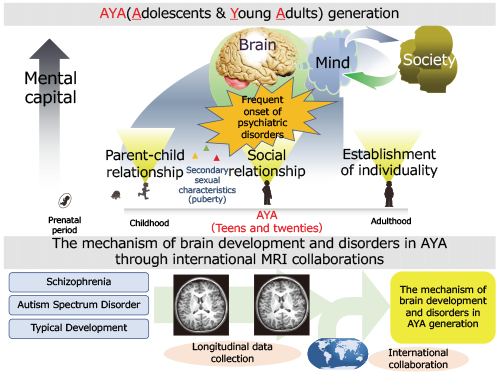
Elucidation of neural circuits of mood disorder in adults and related disorders based on longitudinal MRI data

Yasumasa OKAMOTO
M.D., Ph.D., Professor, Graduate School of Biomedical Medical Sciences, Hiroshima University
We obtain longitudinal MRI data and the associated clinical data targeting mood disorders (depression and bipolar disorders), anxiety disorders, obsessive-compulsive disorders, schizophrenia, subthreshold depression and healthy individuals in adulthood. By using this data and applying AI technology to the analyses, we propose a method to distinguish between bipolar disorder and depression, a method for predicting responses to treatment (clinical course) and biotypes based on the five diseases. We also contribute to the elucidation of the pathogenic mechanism by assessing MRI images showing changes from subthreshold depression to depression.
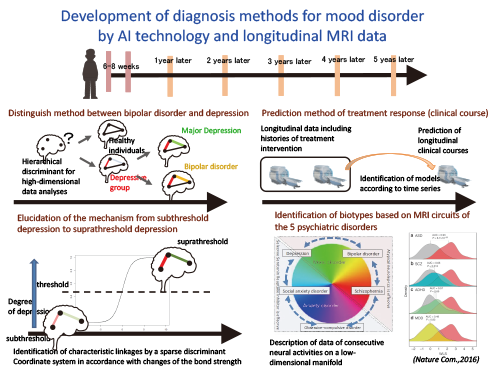
Parkinson’s disease and Alzheimer’s disease Neuroimaging Initiative (PADNI) supported by MRI reference panels based on community-based cohort data

Takashi HANAKAWA
M.D., Ph.D., Professor, Department of Integrated Neuroanatomy and Neuroimaging, Graduate School of Medicine, Kyoto University
Alzheimer’s disease (AD) and Parkinson’s disease (PD) are the most common neurodegenerative disorders involving the elderly population. In this multi-center study, we aim to collect MRI data from participants with either AD or PD, “super-healthy” elderly people defined as being at risk of AD or PD, and intermediate states such as mild cognitive impairment (MCI). Simultaneously, we will develop an MRI reference panel representing the healthy elderly population derived from a mega-scale cohort study including 10,000 participants. By combining a cutting-edge MRI analysis of the multi-center data and the reference panel, we will clarify the similarities and differences of the neural circuits responsible for AD and PD.
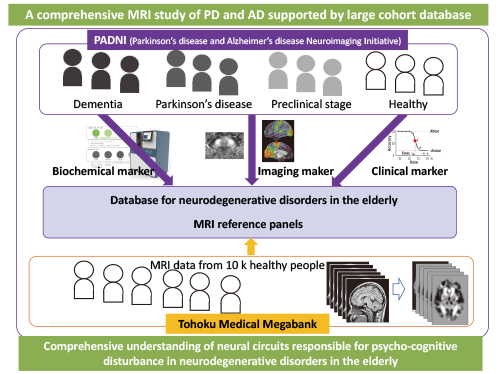
Association study of symptomatic efficacy of rasagiline with neurocircuits in Parkinson’s disease

Nobutaka HATTORI
M.D., Ph.D., Professor, Department of Neurology, Juntendo University
The aim of this study is to accomplish Parkinson’s disease (PD) patient stratification analyzed by machine learning method based on the consecutive, comprehensive, and multi-layered data (cranial MRI including tensor imaging, plasma/serum metabolome, proteome, and miRNA transcriptome of the exosomes) taken from patients with PD treated with/without rasagiline, a potential disease-modifying drug for PD (N Engl J Med 2009, Lancet Neurol 2011). These neuroimaging markers in a data-driven approach would enable us to stratify patients with Parkinson’s disease into distinct clusters, leading to establish novel therapeutic strategies.
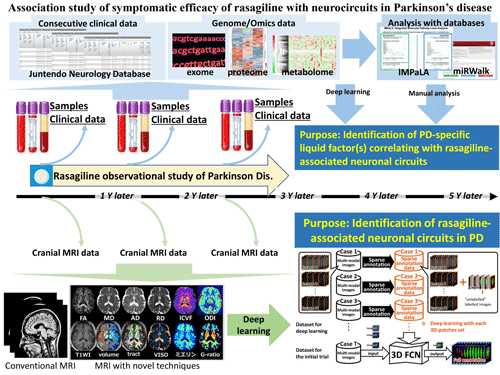
Longitudinal MRI study Identifying the Neural Substrates of Remission/Recovery in Mood Disorders (L/R Study)

Masaru MIMURA
M.D., Ph.D., Specially Appointed Professor, Center for Preventive Medicine,
Keio University Hospital
Mood disorders are a leading cause of disability worldwide. However, despite the importance of understanding the etiology of mood disorders, there are still no established biological markers for their diagnosis and treatment.
First-line treatment strategies for depression, including pharmacotherapy and cognitive behavioral therapy (CBT), are effective only for two-thirds of patients, and the remaining one-third of patients are categorized as treatment-resistant depression (TRD). Repetitive transcranial magnetic stimulation (rTMS) and electroconvulsive therapy (ECT) are neuromodulation treatments for TRD. Psychiatrists usually provide these four treatments for individuals with mood disorders in daily clinical practice. However, it still remains unknown how each therapeutic intervention modulates neural circuits in the process of remission/recovery.
In the current study, we performed a large scale, multi-site, longitudinal magnetic resonance imaging (MRI) study to investigate the neural substrates of remission/recovery, and to identify a prediction model for treatment response/relapse in mood disorder patients.
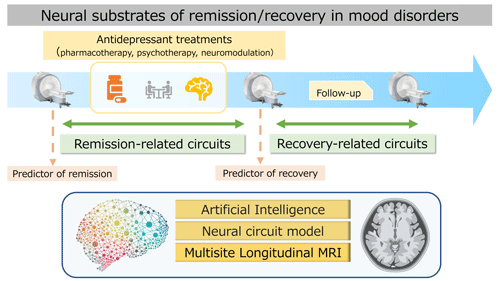
Study of optimization of epilepsy treatment using artificial intelligence

Haruhiko KISHIMA
M.D., Ph.D., Professor, Graduate School of Medicine, Faculty of Medicine, Osaka University
The purpose of this project is to predict the prognosis of seizure suppression after the treatment in patients with epilepsy and to develop neuroscientific evidences to select the best treatment. First, from the Epilepsy Center of Osaka University Hospital and other several hospitals, physiological data, clinical data, before and after treatment, and prognostic data of epileptic patients during each life stage of children and adults are collected. Then we develop an artificial intelligence (AI) that is best suited for prognostic prediction from these data. In addition, based on the prediction with AI and biomarkers, we also establish the optimal treatment selection technology in the treatment of epilepsy.
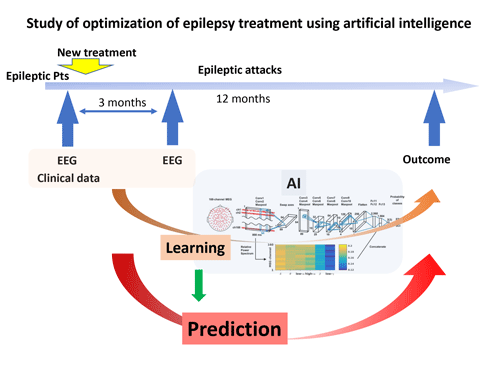
Elucidation of neuroscientific evidence of the effects of cognitive behavioral therapy for eating disorders

Atsushi SEKIGUCHI
M.D., Ph.D., Section Chief, Department of Behavioral Medicine, National Center of Neurology and Psychiatry
Cognitive behavioral therapy (CBT) for eating disorders is a recommended treatment in Japan and overseas. However, the neuroscience mechanism of CBT effect on eating disorder is still unclear.
In this study, we will conduct a longitudinal observational study before and after CBT for eating disorders. We will collect brain MRI, psychological data, clinical data, etc. The aim of this research is to clarify the relationship between therapeutic effects and these data. Finally, we will create neuroscientific evidence of CBT effects that contribute to early detection and early intervention for eating disorder patients.
Specifically, we will identify diagnostic biomarkers of eating disorders by analyzing existing brain image databases of patients with eating disorders and healthy controls. Next, we will identify therapeutic biomarker as well as prediction biomarkers of treatment response of eating disorders by analyzing longitudinal MRI dataset before and after CBT.
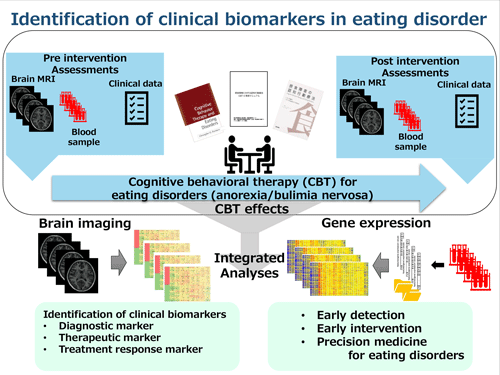
Elucidation of neural basis of pharmacotherapy for attention-deficit hyperactivity disorder

Hidehiko TAKAHASHI
M.D., Ph.D., Professor, Department of Psychiatry and Behavioral Sciences, Graduate School of Medicine, Tokyo Medical and Dental University
In this study, we will conduct multimodal brain imaging in addition to the assessment of clinical symptoms, cognitive and behavioral signs before and after the initiation of methylphenidate (MPH) for individuals with attention deficit hyperactivity disorder. The purpose of this study is to identify the subtype of ADHD who are responders of MPH treatment, and to show the neuroscience evidence of the MPH effect by multimodal brain imaging.
Tokyo Medical and Dental University will exhibit coordination functions for patient recruitment and multimodal brain imaging. Neuropsychiatric Research Institute, Showa University, and National Institutes for Quantum and Radiological Science and Technology respectively will examine each modality of MRI, EEG and PET before and after MPH treatment.
